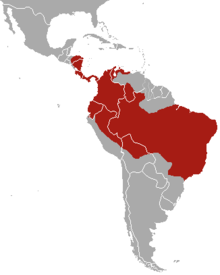Brown-throated sloth
| Brown-throated sloth | |
|---|---|
 |
|
| Scientific classification | |
| Kingdom: | Animalia |
| Phylum: | Chordata |
| Class: | Mammalia |
| Order: | Pilosa |
| Family: | Bradypodidae |
| Genus: | Bradypus |
| Species: | B. variegatus |
| Binomial name | |
|
Bradypus variegatus Schinz, 1825 |
|
| Subspecies | |
|
7, see text |
|
 |
|
| Brown-throated sloth range | |
7, see text
The brown-throated sloth (Bradypus variegatus) is a species of three-toed sloth found in the neotropical ecozone.
It is the most common of the four species of three-toed sloth, and is found in the forests of South and Central America.
The brown-throated sloth is of similar size and build to most other species of three-toed sloths, with both males and females being 42 to 80 cm (17 to 31 in) in total body length. The tail is relatively short, only 2.5 to 9 cm (1.0 to 3.5 in) long. Adults weigh from 2.25 to 6.3 kg (5.0 to 13.9 lb), with no significant size difference between males and females. Each foot has three fingers, ending in long, curved claws, which are 7 to 8 cm (2.8 to 3.1 in) long on the fore feet, and 5 to 5.5 cm (2.0 to 2.2 in) on the hind feet.
The head is rounded, with a blunt nose and inconspicuous ears. As with other sloths, the brown-throated sloth has no incisor or canine teeth, and the cheek teeth are simple and peg-like. They have no gall bladder, cecum, or appendix.
The brown-throated sloth has grayish-brown to beige-color fur over the body, with darker brown fur on the throat, the sides of the face, and the forehead. The face is generally paler in color, with a stripe of very dark fur running beneath the eyes.
The guard hairs are very coarse and stiff, and overlie a much softer layer of dense under-fur. The hairs are unusual in lacking a central medulla, and have numerous microscopic cracks across their surfaces. These cracks are host to a number of commensal species of algae, including Rufusia pillicola, Dictyococcus bradypodis, and Chlorococcum choloepodis. The algae are generally absent in the hair of young sloths, and may also be absent in particularly old individuals, where the outer cuticle of the hair has been lost. Sloth hair also harbours a rich fungal flora.
Over parts of its range, the brown-throated sloth overlaps the range of Hoffmann's two-toed sloth. Where this overlap occurs, the three-toed sloth tends to be smaller and more numerous than its relative, being more active in moving through the forest and maintaining more diurnal activity.
...
Wikipedia

